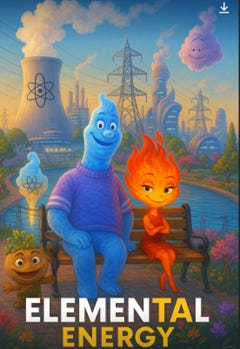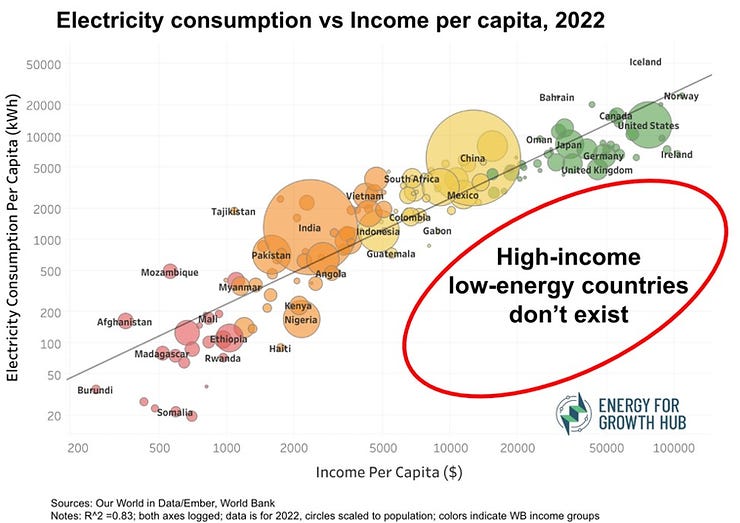Next-generation power is coming from smaller, cheaper, and much faster to build ‘new nuclear’ reactors
By Stephen McBride, The Rational Optimist Substack, June 1, 2025
Imagine a nuclear reactor the size of a shipping container quietly powering your local hospital. It pumps out energy that’s cleaner than natural gas, more reliable than solar, and safer than any other energy source.
A pipe dream? Hardly. Naval sailors have been roommates with nuclear reactors like these for 60-plus years. They work, eat and sleep mere feet from a nuclear core. The USS Wyoming nuclear sub can run for 15 years without refueling, allowing it to hide beneath the Atlantic for months at a time.
That’s some potent technology. Why aren’t we using it for hospitals, factories, data centers and cities?
In a word, The Blight [unnecessary government regulation]. Thankfully, that’s over.
The past: US$30 billion, cathedral-sized nuclear megaprojects that take 15 years to complete and generate more lawsuits than megawatts.
The present and future: Next-gen, factory-built reactors that fit on trucks and install like industrial dishwashers.
Let’s meet the relentless innovators making it happen. Many are clustered in the new nuclear capital of America: Texas!
Texas is becoming world’s nuclear capital
If Texas were a country, it would be the world’s fifth-largest oil producer. It also produces more solar energy than any other U.S. state. Now Texas is staking its claim as the new nuclear capital of America—maybe even the world.
- Natura Resources is building America’s first liquid salt reactor in Abilene, Texas.
- X-energy has inked a deal with Dow Chemical to power its massive plant in Seadrift, Texas with advanced nuclear reactors.
- Last Energy plans to pepper northwest Texas with 30 of its microreactors.
Texas A&M University is becoming to nuclear what Stanford is to tech startups. It is partnering with nuclear innovators Aalo Atomics, Kairos Power, Natura Resources and Terrestrial Energy, opening up land for the companies to build advanced reactors near its Bryan, Texas campus.
Texas’ friendly regulatory environment helps. Its ethos, summed up by one state senator: “We need energy in Texas, we need a lot of it, and we need it fast.”
If I had to go “max long” one state for the next 20 years, it would be Texas. I love that America has 50 “experiments” running simultaneously. While Texas pushes innovation forward, Vermont bans fracking and shuts down nuclear plants.
Pocket reactors fit in a garage
Aalo is building the holy grail—nuclear reactors small enough to fit in a garage, yet powerful enough to support an energy-guzzling data center.
We visited Aalo CEO Matt Loszak at their new HQ in Austin last fall. Aalo recently unveiled its Aalo-1 reactor, which it’s running through testing in the coming months. Here’s the full-scale prototype getting wheeled into its factory (Figure 1).

Aalo is one of the four innovators partnering with Texas A&M. They’re working to deploy up to one gigawatt of nuclear energy to power the university’s AI data centers.
The new breed of nuclear startups is special. I love the sheer variety and entrepreneurial spirit of their founders.
Valar built test reactor in just 10 months
Isaiah Taylor’s superpower is speed. His company built its first test reactor in just 10 months. “I want one.” That’s the gut reaction Isaiah wants to elicit when you first see a Valar Atomics nuclear reactor.
ROS co-founder Dan Steinhart and I visited Valar’s El Segundo HQ last month. Remember, instead of simply generating electricity, Valar will use the energy to pull carbon out of the air and produce synthetic oil and gas.
It recently inked a deal with the Philippines to build its first microreactor. Valar is following the Zipline playbook. American bureaucrats won’t let you build? Prove your tech overseas and then bring it home.
Valar is ditching the drab image of old nuclear. Isaiah knows nuclear must be desirable. “We’re going to put reactors on TikTok,” Isaiah said. “Make nuclear sexy, cool, and aspirational.”


Dan and I stood inside one of those. It felt like a high-end gamer studio, not a Soviet-style control room. Valar’s sleek nuclear rig looks and feels like the future.
Are we building cathedrals or cars?
Traditional nuclear plants are one-off exquisite megaprojects. They take more than a decade to finish and cost tens of billions of dollars.
“New nuclear” reactors (our preferred term for SMRs) are more like Model Ts: standardized products cranked out on an assembly line.
New nuclear is BETTER.
Imagine a self-contained power plant that runs for 5-10 years without refueling. No smoke, no emissions. Just clean, silent electricity.
Now imagine air-dropping that “power plant in a box” next to a data center in Texas, a remote mine in Alaska, or a village in Africa. Or even a frontline military outpost.
That’s what El Segundo based Radiant Nuclear is building. Its “Kaleidos” microreactor fits in a standard shipping container. It can be transported on the back on a truck.
Think of Kaleidos as the iPhone of atomic energy. Just as the iPhone let us all carry supercomputers in our pockets, these compact powerhouses could bring clean, cheap, safe energy practically anywhere.
New nuclear is FASTER.
New nuclear can be assembled in a factory, shipped on a truck and installed in months, not years. Aalo Atomics aims to deploy its microreactor in 60 days, factory to grid.
One of the magic ingredients is standardization. Over the past 70 years in America, we’ve built more than 50 different types of reactors. You can’t build fast if you overhaul the design each time. New nuclear chooses a few brilliant, safe, efficient designs and pumps out as many as possible.
This should speed up the regulatory process too. Once a specific design is approved, replicating it should become much simpler.
New nuclear is CHEAPER.
On average, 70% of the final price tag for a nuclear plant is the interest that piles up on borrowed capital during agonizingly long construction sagas. That stat is so wild I had to triple-check it.
If new nuclear can get reactors up and running in a year, it could cut the final cost of the electricity generated in half. I hope in the future our $10 energy bills itemize and call out the “atomic dividend.”
Small reactors also unleash the learning curve: the more you make something, the more efficient you get. This is how solar panels went from being an exotic, expensive technology to dirt cheap, with costs nosediving an incredible 99.6% over the past 50 years. Practice makes perfect cheaper.
We saw a glimmer of this with Plant Vogtle, America’s newest nuclear plant. The second reactor there was 30% cheaper to build than the first. Workers ironed out issues and learned on the job.
We’re used to electricity costing roughly the same within state lines. New nuclear could change that by creating energy-abundant oases for early adopter cities. And yes, I’d happily live next to a “new nuclear” reactor. If sailors did it safely on cramped submarines for 60 years, why not us?
New nuclear is SAFER.
How do you make the safest energy source on Earth even safer? You simplify it.
Most of these new small reactors are “can’t-fail.” If they get too hot, many are designed to automatically reduce their power or shut down completely. Safety is built into their DNA.
Some – like Radiant’s Kaleidos and Valar’s Ward One reactors – take this even further by having minimal or even no moving parts in their core reactor systems. That means fewer things that could break or malfunction.
We’ve also solved nuclear waste safety concerns.
Some perspective: all the nuclear waste ever generated in America could fit on a single football field, stacked less than 20 feet high. That waste is currently stored in reinforced concrete cylinders called dry casks. But nobody wants to babysit radioactive waste for the next 100,000 years.
This is where nuclear waste startup Deep Isolation comes in. I recently chatted with its CEO Rod Baltzer. His company invented a way to permanently and safely isolate nuclear waste, deep underground, using fracking technology.
Deep Isolation drills a tunnel about the width of a pizza box into solid rock, up to three miles below the surface. At the bottom, the tunnel curves and stretches out like an L-shaped straw. Then they slide in a sealed, corrosion-resistant canister filled with nuclear waste which can stay there for millennia.
Deep Isolation makes waste disappear safely, permanently and affordably.
New nuclear has BETTER CUSTOMERS.
“Yeah, regulation sucks but the real problem is the customers.” I heard this from three separate nuclear startup founders. There’s basically one buyer for nuclear energy today: power companies. They tend to be slow and stuck in their ways.
This is where AI becomes nuclear’s best friend. It’s shifted the conversation to our urgent need for massive amounts of clean, reliable energy to power AI data centers. Nuclear can provide that.
This is why Big Tech is sprinting around, checkbooks in hand, signing deals with “new nuclear” startups.

Julia DeWahl, founder of nuclear startup Antares, told me tech companies are offering triple the going rate for guaranteed nuclear power. The best customers imaginable!
New nuclear has FACTS on its side.
Rational optimists already know energy’s best kept secret: nuclear isn’t the dangerous, dirty monster the media often portrays. But facts don’t move the public – stories do. Like the one about the Three Mile Island accident in the 1970s. No one was physically harmed, but fearmongers made the most of their new villain.
It’s time to spin a new tale… a true tale.
First off, let’s ditch the term “small modular reactor.” It’s jargony and unpopular even among nuclear fanboys. From now on, we’re calling small reactors and the like “new nuclear.” (Though we could have gone with “elemental energy” as a nod to one of my kids’ favorite Disney movies.)

I want my three kids to grow up in a world of cheap, abundant, clean energy. A world where they can dream of building moon bases, desalinating oceans to make deserts bloom, or simply cranking up the AC during a heatwave without shame.
Championing new nuclear is how we achieve that.
One final thought – there is no such thing as a rich, low-energy country. Abundant energy is the foundation of human flourishing. I’ll take any excuse to share one of my favorite charts:

It’s our job as rational optimists to tell nuclear energy’s new story. Please pass it along by hitting those “Like” and “Restack” buttons and by blasting this out on social media.
Stephen McBride is a co-founder of the Rational Optimist Society. To see the original article, click here.
